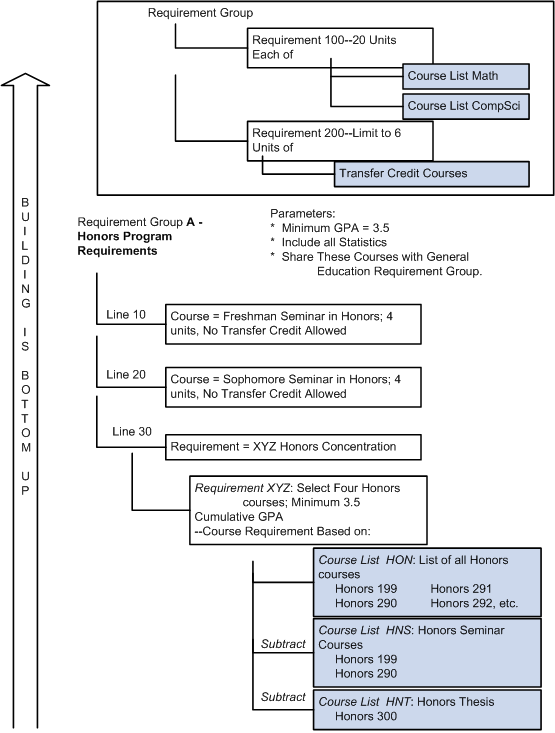Understanding Academic Advisement Concepts
The building blocks of this versatile and effective degree audit system are course lists, requirements, and requirement groups. Academic requirement groups consist of academic requirements that are satisfied by course lists.
A course list is a group of courses that can be used to satisfy an academic requirement. By using the mathematical concepts of union, intersection, subtraction, and complement, course lists can interact in countless ways. As a result, different course lists interacting in different ways can often satisfy the same requirement. The system is designed to maximize the reuse of requirement groups, requirements, and course lists by means of set operations, including union (addition), subtraction, and intersection.
Academic requirements contain requirement parameters, pre-conditions, connector types, partitions, detail requisite, restrictions, and line item parameters. Requirements can be very simple (for example, the only required element may be a GPA of 3.000) or very complex (for example, the required elements may be expressed in multiple requirement line items using partition sharing).
Requirement groups consist of detail lines pointing to conditions, courses, and requirements as well as parameters that include unit and course requirements. The advisement engine evaluates each student's career, program, plan, and sub-plan (plus other pertinent academic data) and determines which requirement groups apply to that student.
Because of the underlying concepts used to establish requirements and to execute degree audits, Academic Advisement is a powerful yet flexible tool. The underlying structure relates to the use of the elements of academic structure.
Traditionally, the academic structure of an institution is built from the top level down (for example, the total number of units needed to graduate through specific requirements for programs and plans). This traditional approach to academic structure is still valid and very necessary; however, while making use of this approach, the Academic Advisement application is built from the bottom level up (for example, course lists are defined first, followed by academic requirements, then requirement groups).
Note: As mentioned, academic requirement groups consist of academic requirements that are satisfied by course lists. However, in order for the academic advisement portion of PeopleSoft Campus Solutions to work correctly, you must set up or establish the pages in the reverse order. First, define course lists, then set up academic requirements, and then establish requirement groups. Therefore, in the Academic Advisement navigation, the setup components are listed in this order: Define Course Lists, Define Academic Requirements, and Define Requirement Groups.
The following diagram presents a traditional four-year institution's degree requirements and the academic structure level at which the rules apply.
Image: Traditional approach to academic advisement concepts (Part 1)
This two-part diagram depicts the traditional approach to academic advisement concepts.

This diagram expresses the degree requirements (from the Part 1 diagram) using academic advisement concepts of course lists, requirements, and requirement groups.
Image: Traditional approach to academic advisement concepts (Part 2)
This two-part diagram depicts the traditional approach to academic advisement concepts.
